 |
||
|
||
| ||
 On the background of fighting between new and almost new graphics processors from NVIDIA and STMicroelectronics we have already forgotten that the KYRO II is a predecessor of the KYRO. But this technology is just earlier and, therefore, slower in a realization frequency. And we shouldn't ignore video cards on this chipset, first of all, due to their low price. The theoretical issues on the tile architecture and the technological peculiarities of the KYRO and KYRO II are highlighted in the following articles: Video cards on the KYRO/KYRO II are constantly kept an eye on in our 3Digest, where you cam look at the performance and quality of 3D-graphics of these cards. The concept of the KYRO combines simplicity of the cards, cheap SDR memory, and at the same time, quite high speed results as compared with their competitors, and strong diversity of the performance in different games. Besides, the drivers are constantly being debugged. On the one hand, it means that the product is improving and developing; on the other hand, there is an example of the ATI RADEON when the product was released with rather raw software. The company was debugging the drivers nearly a year, while NVIDIA occupied the market leaving for ATI just only crumbs on the PC-video card market (I don't mean the mobile and ╬EM market). Today ATI has some share only due to very low prices for RADEON cards. KYRO / KYRO II has the same situation in the field of the software. I can state that the representatives of STM/ImagTech read reviews, look for unpleasant comments of operation of the cards in the certain games, and then release a new version of the drivers. After that they write letters with suggestions to test the KYRO cards again. On the one hand, it is pleasant that the debugging process is so fast, but, on the other hand, how dare they release products with raw software? Why do the drivers pass a debugging process only for several popular games? Why do the drivers work perfectly on old and relatively new platforms (i440BX, i815, VIA KT133) and on the latest they hang (i850, AMD760)? On the whole, the KYRO products are rather good. Unfortunately, the situation connected with such a way of debugging of drivers is unpleasant. A buyer of such a card must has an Internet access all the time to update the software. But the KYRO deserves attention not only due to a low price for its cards, but also due to a series of interesting technologies which allow them to lift the performance in the 3D (much more than just by 2-5 fps). Today we will examine one of a KYRO based video cards - Hercules 3D Prophet 4000XT. CardThe Hercules 3D Prophet 4000XT has AGP x2/x4 interface, 32 MBytes SDR SDRAM located in 4 chips on the front side of the PCB. 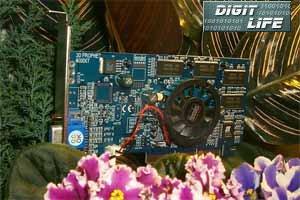   Samsung produces memory chips with a 7 ns access time, which corresponds to 143 MHz. But the memory works at 115 MHz, as well as the chip, because the frequencies of the processor and the memory are synchronized. That is why the memory has a good overclocking potential, but it is, unfortunately, limited by the chip's speed. The card doesn't follow the reference design from Imagination Technologies. The difference consists in the arrangement of the memory chips. Besides, this PCB has a smaller size. The card is traditionally sky-blue. It provides the space for a TV-out chip. The respective connectors (RCA, S-Video) are absent. The GPU is equipped with a roundish cooler with an effective fan. It is similar to the Blue Orb from ThermalTake, but the heat sink has a completely different configuration. 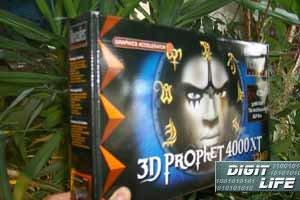 The card ships in a dark Retail-package with a picture of a soldier or a magician. In the box you can find:
OverclockingThe Hercules 3D Prophet 4000XT doesn't overclock (operation at 118 MHz is not considered as such). We have already written that the peculiarities of the architecture of this chip doesn't allow for lifting the frequency. Installation and driversTest system configuration:
For testing we used drivers from STMicroelectronics of 7.00.103, VSync was off, the forced texture compression technology was used. For comparison the results of the following cards are given: ASUS AGP-V7100 Pro (NVIDIA GeForce2 MX400, 200/200 MHz), reference card NVIDIA GeForce2 MX (175/266 MHz). Test resultsThe 2D quality is just excellent. In 1600X1200 at 75 one can see a sharp image. For estimation of 3D quality we used the id Software Quake3 v.1.17 - a game-test which demonstrates the card's operation in OpenGL with usage of a standard demo-benchmark demo002 . Quake3 Arenademo002, standard settingsThe tests were carried out in two modes: Fast (shows card's work in 16-bit color) and High Quality (shows card's work in 32-bit color). 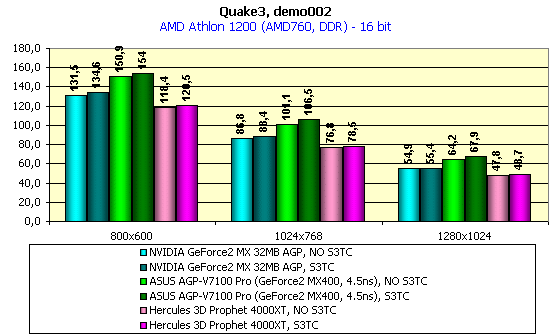  In the 16-bit color the KYRO falls behind even a usual GeForce2 MX, not to speak of the GeForce2 MX400 with the 4.5ns memory. The activation of the S3TC hasn't helped here. In the 32-bit color the Hercules 3D Prophet 4000XT performs not worse than the ASUS AGP-V7100 Pro!, first of all, thank to the texture compression. In our 3Digest in the S3TC part I am studying this issue in detail, that is why I recommend you to read this material, where you can also look at the screenshots and make sure that the activation of the texture compression worsens the quality of the KYRO to the least extent among all 3D chips. demo002, the highest qualityThe tests were carried out in 16-bit and 32-bit color at the highest quality (geometry detailing - High, a toddler of the texture detailing level - in the position #4). 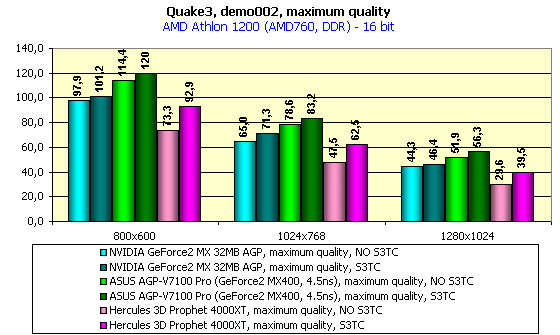 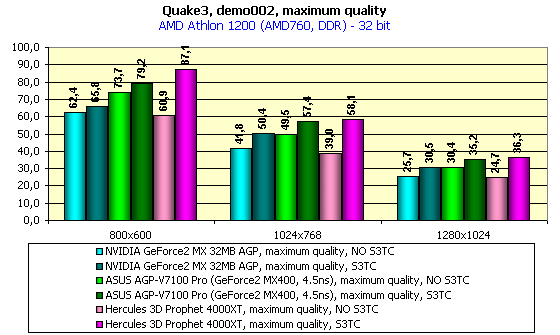 In 16-bit color the situation is similar to the previous test. But the S3TC bears fruit, and the gap is not so critical! If you remember that the quality of the 16-bit color of the KYRO is excellent, you can make the conclusion yourself. The 32-bit color has brought nearly the victory to the KYRO! Both the GeForce2 MX and the twice more expensive GeForce2 MX400 (4.5ns memory) have lost! ConclusionI must only add to the words said above that activation of the S3TC in the Direct3D doesn't practically worsen the quality (the most of errors are corrected in the latest versions of the drivers). I just don't recommend to enable the texture compression on the games based on the UnrealTournament engine. But not everything is so perfect. The card can't boast about its stability on i850 (Pentium4) and AMD 760 (Athlon, DDR SDRAM) platforms. Besides, there are some drawbacks connected with the KYRO's architecture: first of all, a strong fall of the speed when the trilinear filtering is enabled, and the severe performance decrease when the anisotropy is activated. However, activation of the S3TC together with the trilinear filtering makes the losses of the latter smaller. In the May 3Digest you can find a full comparison of characteristics of cards of this and other classes. The KYRO based cards cost today even less than the GeForce2 MX, that is why the only obstacle in the way of popularization of these cards is a small number of companies which are producing them. Highs:
Lows:
Write a comment below. No registration needed!
|
Platform · Video · Multimedia · Mobile · Other || About us & Privacy policy · Twitter · Facebook Copyright © Byrds Research & Publishing, Ltd., 1997–2011. All rights reserved. |